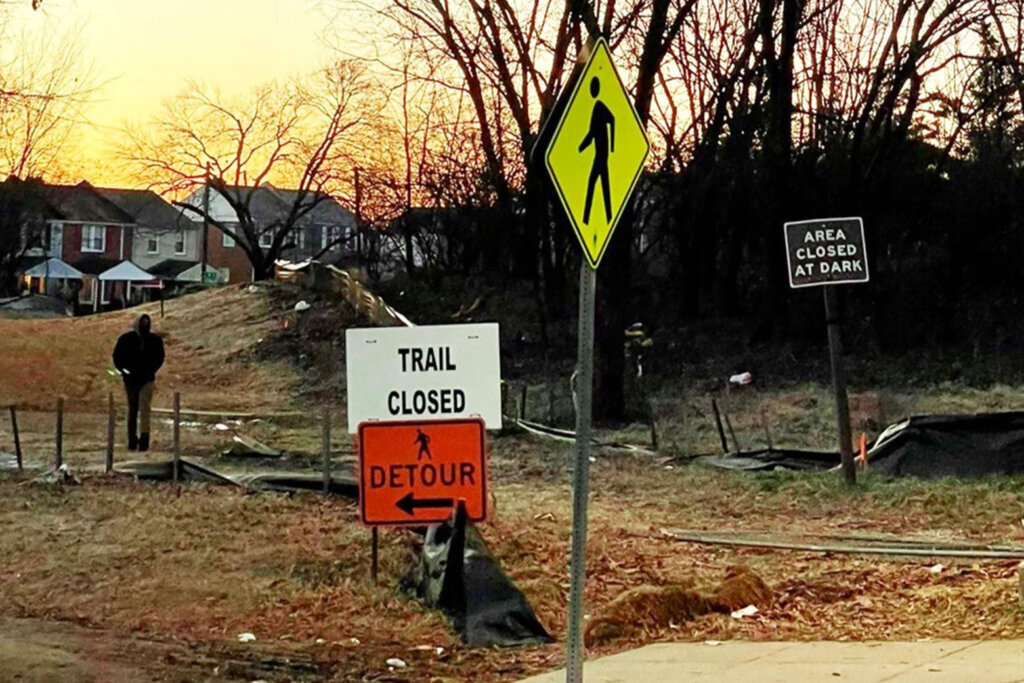
U.S. Army Corps of Engineers spokeswoman Cynthia Mitchell told WTOP a 75 mm shell discovered in mound of soil by a National Park Service employee “has a liquid fill that will require further analysis.”
The U.S. Army is still trying to identify an unknown liquid found inside one of two World War I-era weapons that were discovered three weeks ago, in Fort Totten Park, in Northeast D.C., and whether there’s a connection to the chemical weapons found during the decadeslong cleanup of a former chemical weapons site near the American University campus.
U.S. Army Corps of Engineers spokeswoman Cynthia Mitchell told WTOP a 75 mm shell discovered in mound of soil by a National Park Service employee was empty, after analysis at Marine Corps Base Quantico.
However, “the 6-inch Livens projectile has a liquid fill that will require further analysis,” Mitchell said.
A Livens Projector was a simple mortar-like weapon that could throw large drums filled with toxic or flammable chemicals. The weapons were used during World War I, specifically between 1916 through 1918.
Livens projectors were encountered often during the Ward 3 Spring Valley cleanup, at the former American University Experiment Station used by the U.S. government for research and testing of chemical agents, equipment and munitions — once dubbed the “mother of all toxic dumps.”
However, the recently-discovered weapons found at Fort Totten may not be an exact match with the weapons found in the Spring Valley cleanup.
Mitchell said the Army is “still analyzing its options for obtaining additional characterization data on the liquid fill within the Livens. That action is complicated by the experimental nature of the work conducted in the 1920s by American University.”
What’s next at Fort Totten?
The temporary lack of clarity of whether the liquid poses a potential health or safety risk is pausing discussions of whether a major cleanup might be required in the park, located in a Ward 5 neighborhood, near the Fort Totten Metro.
However, the U.S. Army Corp of Engineers has taken preliminary steps to facilitate additional cleanup, by installing erosion control matting. “This matting provides stabilization of the site, protecting the berms against erosion and rainfall.”
“Fencing will also be installed this week and will remain in place during ongoing assessments which will help determine a path forward at Fort Totten Park,” according to an Army Corps. statement.
The time-intensive, expensive Spring Valley Cleanup focused on a site at 4825 Glenbrook Road, under a home which was knocked down in 2012.
By the end of the project, in November 2021, the Army corps said it remediated, removed or recovered 556 munition items (23 of them filled with chemical agents), more than a ton of laboratory debris, 53 intact and sealed glass containers of chemical agent and 7,500 tons of contaminated soil.
However the possible link to Fort Totten may have occurred years before the start of the Spring Valley cleanup.
Even before a contractor digging a utility trench in Spring Valley in 1993 uncovered a buried military ordnance, which prompted the Army Corps of Engineers investigation that revealed homes on Glenbrook Road were built atop chemical weapon burial pits, contaminated soil from Glenbrook Road was trucked to a landscaping project at Fort Totten Metro station.
Dan Noble, of the U.S. Army Corps of Engineers, and project manager for the ongoing Spring Valley Formerly Used Defense Site project told WTOP in a 2022 interview.
“What we know is that over at Fort Totten, where the D.C. Metro project was underway, they had a need for soil, and on Glenbrook Road, where they were building the houses, they had excess soil,” Noble said. “We know that an arrangement was made to transfer some soil, from Glenbrook Road, over to Fort Totten.”
In 1992, the heavy equipment operator spreading Glenbrook Road soil at the Fort Totten Metro site felt sickened from the fumes of the soil, and the U.S. Park Service ordered it be removed, Noble told the Spring Valley Restoration Advisory Board. The board holds regular meetings to advise community members on the cleanup.
Where the contaminated Glenbrook Road soil was ultimately sent, after being removed from the Fort Totten Metro site is unknown, according to the U.S. Park Service and the Army Corps.
D.C. Del. Eleanor Holmes Norton and ANC commissioners Zachary Ammerman and Gordon-Andrew Fletcher have been calling on the National Park Service to more fully search the Ward 5 park, to investigate a possible link to the Spring Valley cleanup of chemical weapons.
On Wednesday, Norton issued a follow-up letter to the National Park Service and Army Corps of Engineers, seeking a thorough search throughout the park for other weapons, and soil and groundwater contamination.
“Given the fact that multiple munitions have been found over the years in different areas of Fort Totten Park, I, once again, ask that you investigate ordnances and soil and groundwater contamination throughout the park,” wrote Norton.
Today, @EleanorNorton issued a followup letter to NPS, again asking that @RockCreekNPS investigate the entirety of Fort Totten Park for toxic waste, as I have been pressuring the National Park Service to do for months. pic.twitter.com/FClU3LDwaJ
— Zach Ammerman, ANC 5A09 (@ZachANC5A09) May 10, 2023
The Army Corps said it urges the public to “steer clear of park closures and abide by the ‘No Trespassing’ signage installed by the National Park Service.”
Stay connected with us on social media platform for instant update click here to join our Twitter, & Facebook
We are now on Telegram. Click here to join our channel (@TechiUpdate) and stay updated with the latest Technology headlines.
For all the latest Health & Fitness News Click Here
